Distinguished Critique: Cosmic Odyssey Review
A master storyteller can't quite apply his trademark characterization to a series too short for its ensemble cast
—by Nathan on October 11, 2023—
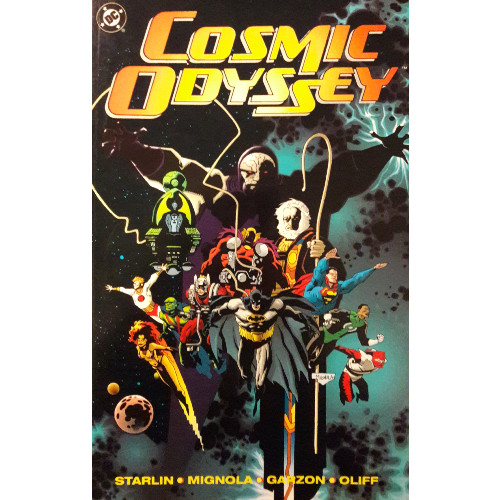
Discovery. Disaster. Decisions. Death.
Such is the process which awaits our assembled heroes in Jim Starlin and Mike Mignola’s four-part crossover series. When last we visited Apokolips, in 1986, Darkseid was laboriously striving to turn Earth against its costumed heroes. Nearly three years later, the fearsome New God is forced to bend a knee and ask for succor from his greatest foes.
A darkness threatens all of existence–the Anti-Life Equation. Originally the subject of Darkseid’s greatest desire, it has become a thing of nightmares. Darkseid, powerful as he is, cannot stave off the Equation’s might alone. So he assembles a group of his New God adversaries and Earth-bound enemies to help him in his weakness.
Sounds pretty epic, right?
Cosmic Odyssey
Writer: Jim Starlin
Penciler: Mike Mignola
Inker: Carlos Garzon
Colorist: Steve Oliff
Letterer: John Workman
Issues: Cosmic Odyssey #1-4
Publication Dates: December 1988-March 1989
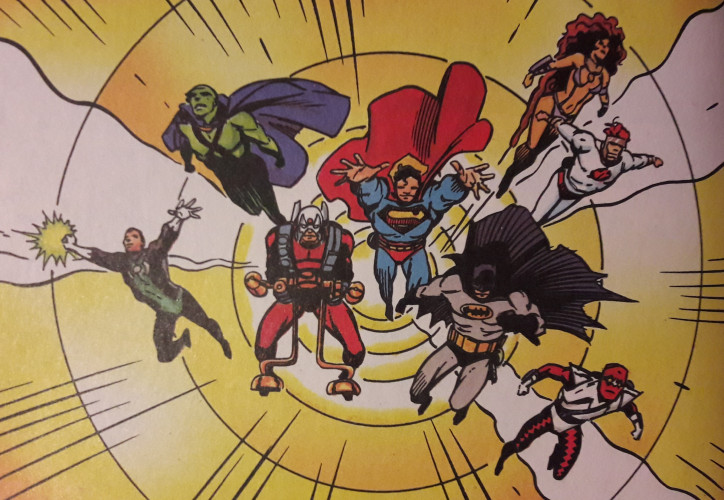
Note: save for some minor edits, this blog is the same as it was when I originally posted it to Hubpages
Jim Starlin is no stranger to cosmic epics. Over at Marvel, he penned the adventures of Captain Marvel and Adam Warlock, taking B-list characters and modernizing them both for the times; he brought about the end of Mar-Vell’s life in Marvel’s first-ever graphic novel, The Death of Captain Marvel; he had Thanos wipe out half the universe with a single snap during The Infinity Gauntlet. If anyone could write a stirring soap opera in space, it should be Starlin.
You can see, if you peer close enough, bits and pieces that Starlin brings over from his time at DC’s main competitor. His Marvel creations Thanos, Mentor, and Eros of Titan, upon their inception, felt like copies of Jack Kirby’s Darkseid of Apokolips and Allfather and Lightray of New Genesis. Here, he plays to the inverse of the characters he crafted–his Allfather feels like, an older, wise leader of an entire planet; his Lightray hits on Starfire, much like Eros’ womanizing; his Darkseid brings the same level of menace and manipulativeness that Thanos utilizes in his stories. Starlin’s command over those characters feels like a direct result of the sagas he wrote for Marvel, and though I do not know how much material Starlin copies exactly from Jack Kirby’s New Gods, the connections are, at least here, strong.

It makes sense, then, that Starlin best utilizes Darkseid, presented much in the way the writer depicted Thanos, specifically in his Warlock issues. While John Ostrander and Len Wein played up Darkseid’s menace and villainy in Legends–setting him up as a prime post-Crisis on Infinite Earths antagonist–Starlin introduces some complexity. Darkseid first assembles our heroes–Superman, Batman, Green Lantern (John Stewart), Martian Manhunter, and Starfire from Earth, and Orion and Forager from New Genesis–concerned about the galactic threat the Anti-Life Equation poses. Starlin transforms the Equation into an entity, a physical embodiment of death, discord, and destruction, accidentally freed from an alternate dimension and seeking to wreak havoc across the stars.
Darkseid’s motivations and actions waffle between genuine and suspect throughout the entire series, with our heroes warily eyeing him and determining whether he’s worthy of trust. He feels more complex than Ostrander and Wein’s version of the character, less given to philosophical dithering and more aligned with careful dictation and plans within plans. That Darkseid goes out of his way to prove his trustworthiness to our heroes should leave you either convinced of his genuineness or suspicious of his specificity…you decide.
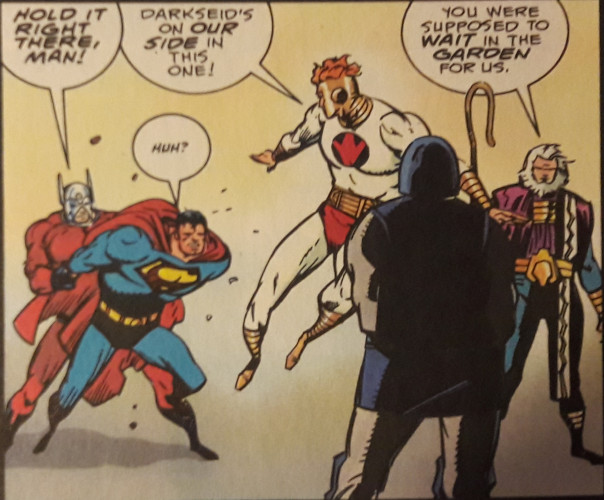
Starlin attempts to craft a spacebound "classic journey," with our heroes splitting into pairs and racing to different locations to halt the Anti-Life Equation’s plan (titling the series "Cosmic Odyssey" brings to mind a space-faring saga worthy of the long-suffering journeys of one mythical king of Ithaca). Through this set-up, Starlin teams seemingly incompatible heroes together as a way to toy with personalities and tensions. And he tries, he really tries. You see friction and turmoil dance around the edges of our characters. Compassionate Superman and hot-headed Orion disagree on how to handle conflict on Thanagar; Martian Manhunter finds himself debating John Stewart’s arrogance and impetuousness; Batman and Forager briefly clash on account of their different backgrounds; Lightray, uh, hits on Starfire...really nothing of consequence happens there. But three of our four pairs seem intentionally placed at odds, to stir up tensions between personalities or philosophies.
The premise portends engaging conflict and character development, which Starlin only achieves partially. The Superman/Orion subplot comes to a head quickly and is resolved as fast it flares up, with our heroes reaching little more than a stalemate over their differing philosophies; Batman and Forager quickly understand one another, and while their brief conflict is kept to a bit of banter, I would have preferred seeing each man come to a better understanding of one another throughout the series, a concept Starlin leaves to implication outside a few action sequences. With his characters broken into four groups, plus the Darkseid narrative running alongside, Starlin just does not have enough time to focus deeply on each pairing.
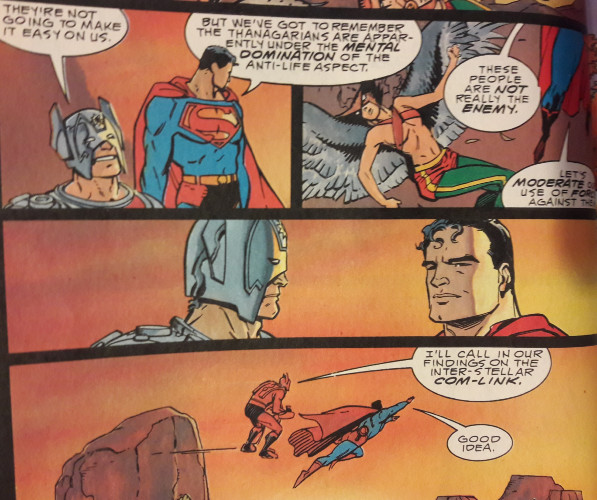
Which brings us to the Green Lantern/Martian Manhunter subplot.
Other Cosmic Odyssey reviews I examined singled this pairing out as a point of contention. Without spoiling much of the plot, I will merely mention that John Stewart makes a critical mistake, his hubris and rash behavior putting him at odds with J’onn J'onzz and severely impacting their mission. I don’t know if this is in line with how Stewart was depicted at the time–his actions actually seem more aligned with Guy Garnder’s personality–but based on my less nuanced understanding of the character overall, Starlin’s treatment of him feels off. And the Manhunter’s response to this incident feels severe, especially in a later moment which really should be cathartic between the two heroes.
I get it. Heroes make mistakes (especially when they’re a little "green"), and as readers have no doubt witnessed in other narratives, these mistakes can have devastating consequences. But John’s brashness feels out-of-character, introduced a little late in the game and, in certain cases, coming across more as confidence than overt, selfish boldness. The Manhunter’s reaction to the whole ordeal is appropriately emotional yet far too blunt; a later discussion between the two heroes does little to soothe tensions–there’s a sense that Manhunter utilizes reverse psychology on John to help him through self-inflicted trauma, yet this is presented coldly.
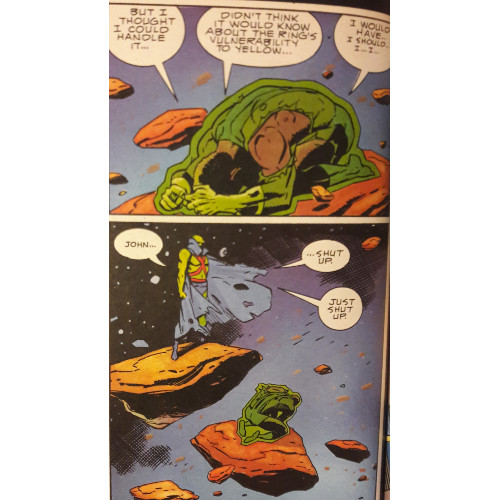
These myriad strands of characterization–which waver between engaging and misunderstood–are frustrating to encounter, particularly given Starlin’s status as a master storyteller. This may just boil down to the series’ four-issue format and the size of its cast; as noted, Starlin just doesn’t have the space necessary to get into the gritty details regarding his heroes. Thus, characterization is defined by moments and brief bits of dialogue, transformation and development restricted to single panels.
A young Mike Mignola, a few years before he created Hellboy, provides pencils for the series. He seems to relish in developing futuristic alien worlds, crafting all manner of technology, with gizmos and gadgets given sufficient buttons, wires, control pads, and screens to look properly science fiction (I would assume some credit is due Jack Kirby for the specific New Genesis scenes where such imagery appears). Fight scenes are dramatic, especially where Mignola creates hulking nemeses for our heroes to combat. His characters are angular and rough–his Superman is nowhere near as boyish as Tim Sale’s, his Darkseid maintains a steely grit John Byrne’s lacked, and his Batman is a perfect blend of shadow and humanity. Colorist Steve Oliff imbues each environment with the correct palette–his Batcave is swept in foreboding shadow, contrasted by his New Genesis, which is bright and full of technological marvels; a dimension where the Anti-Life Equation resides is grim and dotted with pockets of dangerous energy. Considering how often the narrative switches location, Oliff works well with Mignola to offer each planet and dimension its own recognizable landscape and identity.
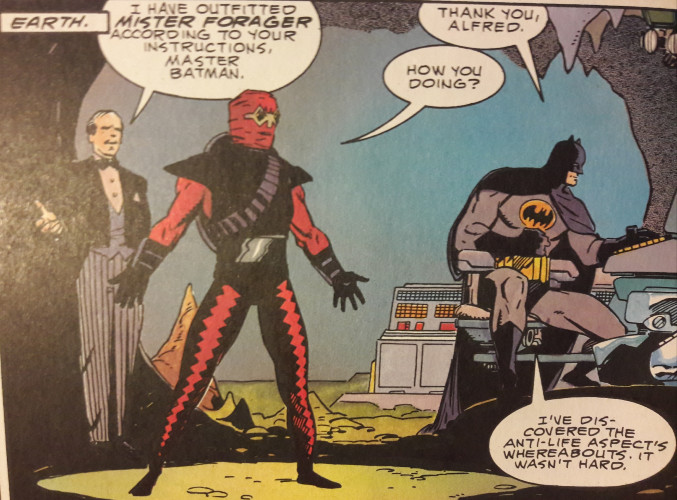
I’d love to say I appreciated Cosmic Odyssey more than I did, which is a shame. Jim Starlin crafted some incredible space sagas for Marvel, so it’s disappointing he’s unable to pull out that same magic here. He certainly tries, keeping readers on their toes with the brisk pace of his multi-team, multi-location narrative. Yet he ends up bopping around the universe a tad too much to create the most cohesive narrative or imbue his story with rewarding characterization. Hints of deeper connections between characters exist, but they’re never allowed to develop into engaging commentary or, as in the case of the Green Lantern/Martian Manhunter subplot, are mishandled. Mignola does well with the story he’s given, particularly when paired with Oliff, but even he can’t quite find life in a tale so dedicated to its opposite number.